Goodbye, 2021: A look back at the year that was
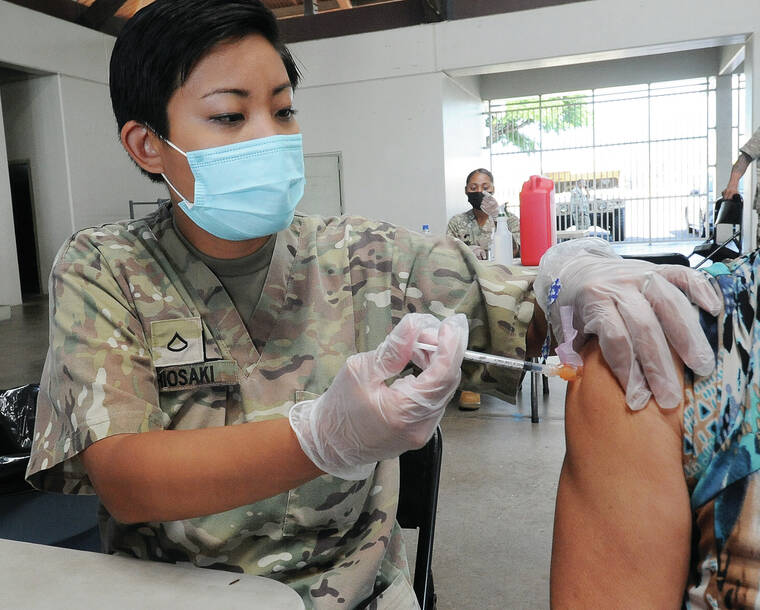
Hawaii Army National Guard medic Kelsea Shiosaki administers a COVID vaccine Nov. 23 at Old Kona Airport Park. (Laura Ruminski/West Hawaii Today)
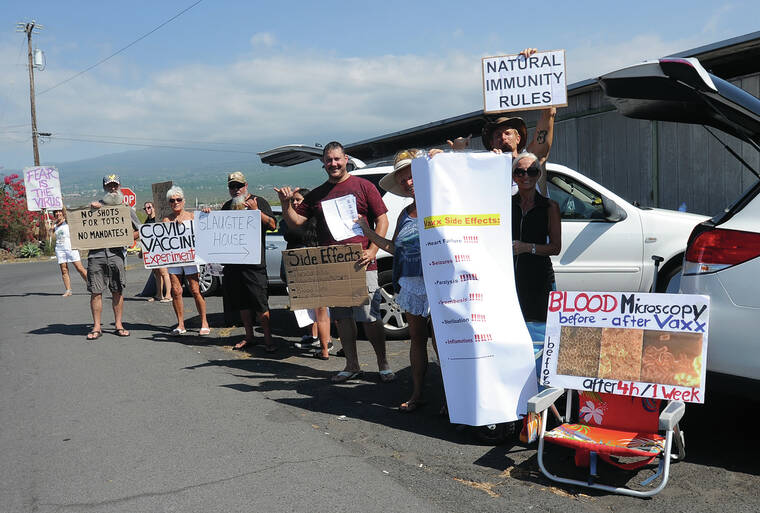
Protesters wave signs at Old Kona Airport Park Nov. 23 where a free vaccine clinic was taking place. (Laura Ruminski/West Hawaii Today)
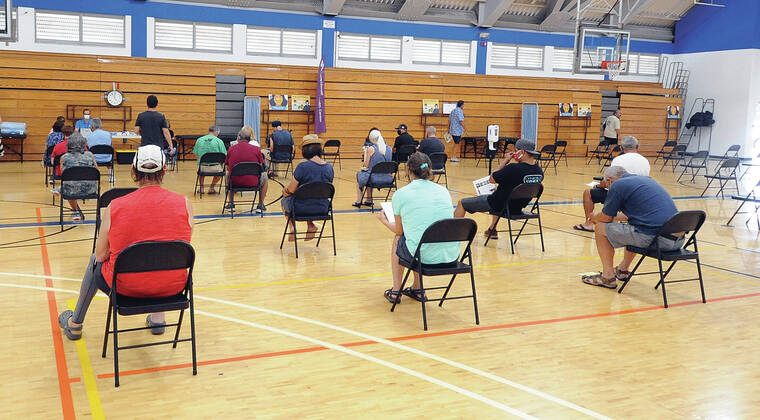
Vaccinated individuals wait 15 minutes after receiving their dose in May at Kekuaokalani Gymnasium in Kailua-Kona. (Laura Ruminski/West Hawaii Today)
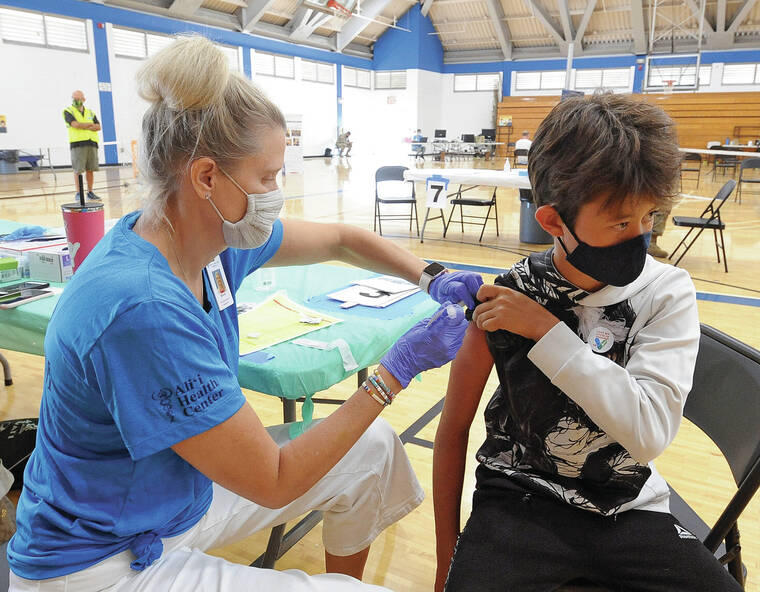
Kona Community Hospital Chief Nurse Executive Diane Hale administers a COVID-19 vaccine to 12-year-old Conlan Okagi in May at Kekuaokalani Gym. (Laura Ruminski/West Hawaii Today file photo)
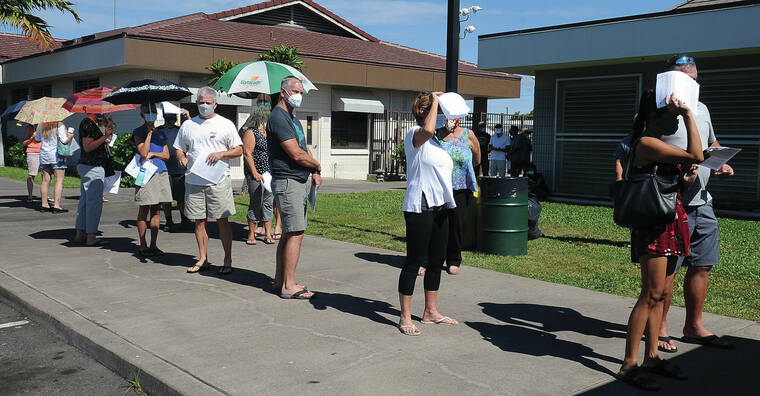
Kupuna and essential workers wait in line for their vaccine at West Hawaii Community Health Center's second walk up vaccine clinic in March at Kekuaokalani Gymnasium. (Laura Ruminski/West Hawaii Today)

Nona Jin Duggan, RN behavioral health, administers the first of two doses of Pfizer's COVID-19 vaccine to Russ Starkey Jan. 21 at Kona Community Hospital. It was the first day the hospital administered vaccines to those 75 and older. (Chelsea Jensen/West Hawaii Today)
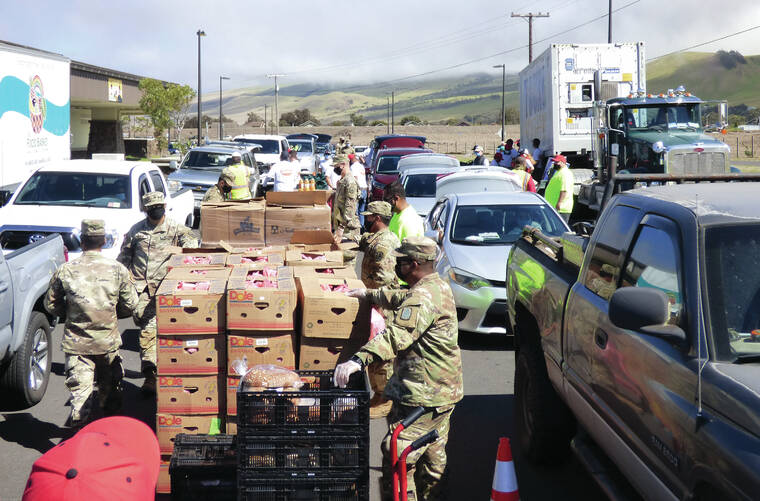
Parker Ranch partnered with The Food Basket for the nonprofit’s 152nd Ohana Food Drop with a special paniolo treat for the North Hawaii community on July 2 in lieu of the legacy ranch holding its annual Fourth of July rodeo. (Chelsea Jensen/West Hawaii Today)

Vehicles line up June 19 ahead of the start of The Food Basket's Ohana Food Drop at Old Kona Airport Park in Kailua-Kona. (Chelsea Jensen/West Hawaii Today)

A U.S. Army Blackhawk helicopter picks up water from a tank along Old Saddle Road to douse hotspots on the southern flank of the 40,000-plus-acre blaze Aug. 3. Chelsea Jensen/West Hawaii Today
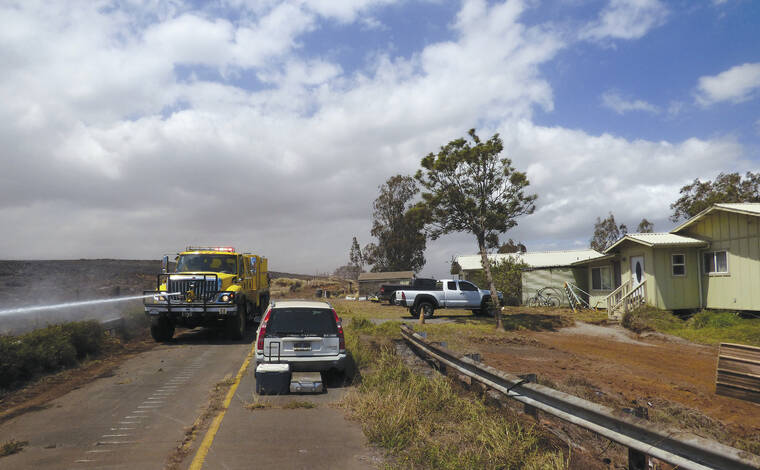
A Hawaii Fire Department tanker sprays down hotspots Aug. 3 near Donald Morgan's home in South Kohala. (Chelsea Jensen/West Hawaii Today)
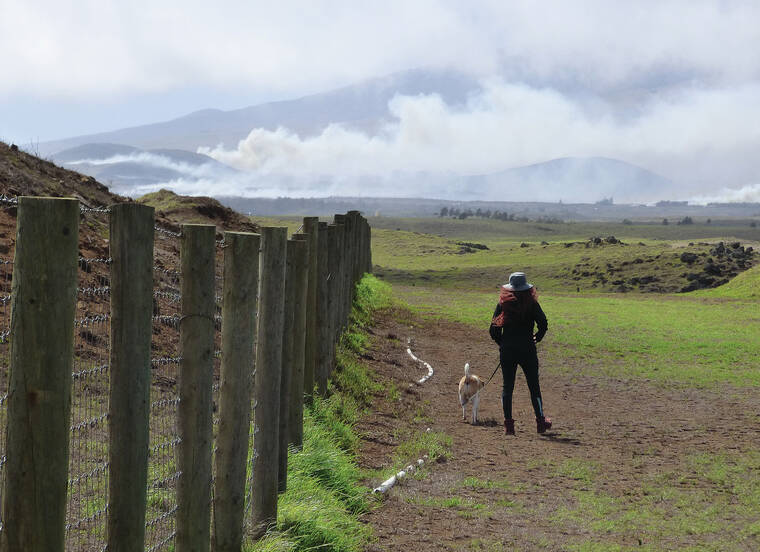
A woman walks her dog at Waimea District Park Aug. 1 as a large wildland fire that broke out above Mana Road on Friday continues to burn. (Chelsea Jensen/West Hawaii Today)
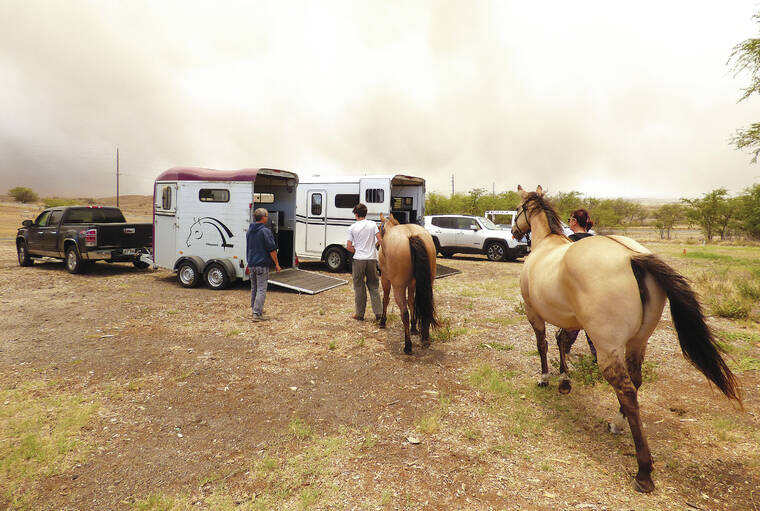
Owners of horses evacuated Waikoloa Stables from Waikii Ranch as the fire threatened that community July 31 are loaded Aug. 1 following a mandatory evacuation order for Waikoloa Village. (Chelsea Jensen/West Hawaii Today)
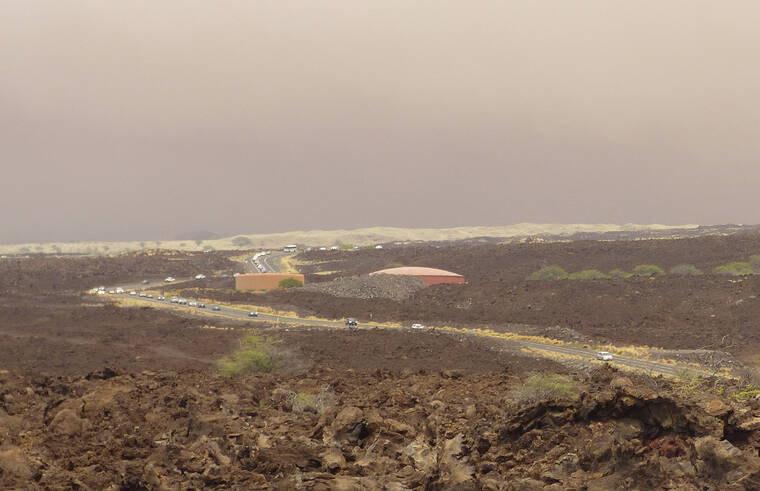
Vehicles were backed up Waikoloa Road after a mandatory evacuation was ordered as a wildland fire approached the Waikoloa Village area Aug. 1. A second emergency route was later opened from Hulu Street to Queen Kaahumanu Highway to provide residents another way out of the South Kohala Town. (Chelsea Jensen/West Hawaii Today)
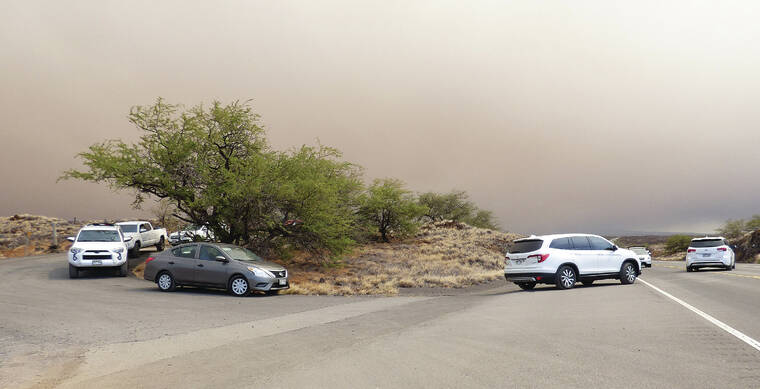
Vehicles exit Aug. 1 from an emergency route opened from Hulu Street in Waikoloa Village to Queen Kaahumanu Highway to provide residents another way out of the South Kohala Town. (Chelsea Jensen/West Hawaii Today)
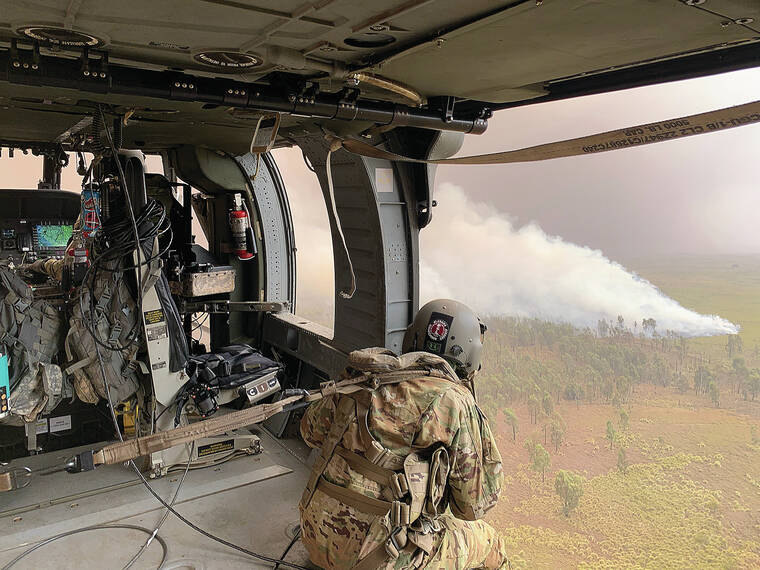
U.S. Army resources from the Pohakuloa Training Area, including four UH-60 Blackhawks and one CH-47 Chinook, assisted in the effort to douse the Big Island's largest wildland fire in history by providing water drops as seen here on Aug. 1. (Courtesy photo/Special to West Hawaii Today)
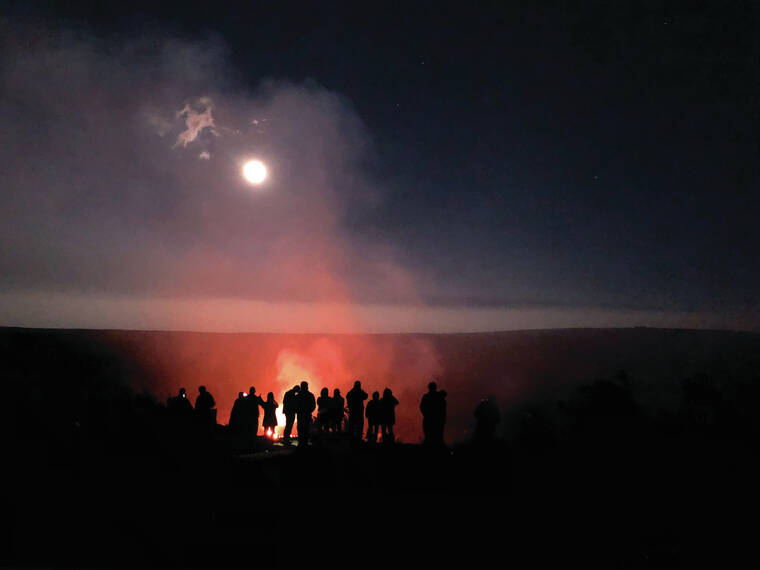
Kelsey Walling/Tribune-Herald Visitors take videos and watch lava fountain from the viewing spot at the Keanakako'i overlook at Hawaii Volcanoes National Park.
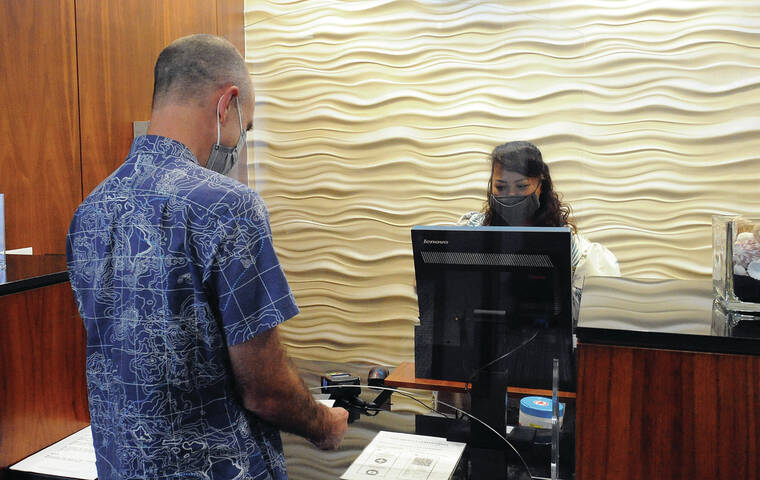
A guest checks in King Kamehameha's Kona Beach Hotel in March. (Laura Ruminski/West Hawaii Today)

On Christmas Day, Animal Control officers were hard at work responding to a 5 a.m. call of an injured dog in lower Puna. The Hawaii Police Department assumed hands-on management animal control services on July 1, following years of contracts with Hawaii Island Humane Society and a short-lived contract with Hawaii Rainbow Rangers that was terminated amid a number of concerns, including alleged mismanagement of county funds, months-long delay into transition into full services, substandard facilities maintenance, unfinished reports and staff retention issues. (Hawaii Police Department/Special to West Hawaii Today)
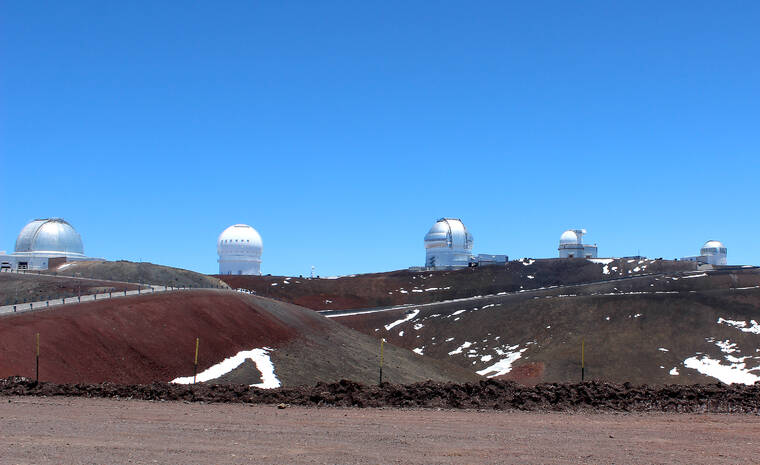
Observatories on Maunakea. (Chelsea Jensen/West Hawaii Today)



















As we bid a perhaps not-so-fond farewell to 2021, the novel coronavirus pandemic continued to be the most important story of the year, as it had been in 2020 — locally, statewide, nationally and worldwide.
As we bid a perhaps not-so-fond farewell to 2021, the novel coronavirus pandemic continued to be the most important story of the year, as it had been in 2020 — locally, statewide, nationally and worldwide.
As in any year, some notable Big Islanders bid us aloha in 2021. That list begins with former Mayor Billy Kenoi, who died Jan. 26 of myelofibrosis, a rare form of leukemia he’d battled since 2015. He was 52. The Hawaiian Homes Commission adopted a resolution honoring Kenoi at its February meeting. The resolution compared Kenoi’s public speaking skills to those of Prince Jonah Kuhio Kalanianaole, the architect of the Hawaiian Homes Commission Act of 1920.
Others who died in 2021 include: Guy Paul, 85, retired Hawaii County Police chief, March 18; Ken Staton, 83, retired music educator and conductor at the University of Hawaii at Hilo, April 3; Chad “Kalepa” Baybayan, 64, master (pwo) navigator and a captain of the Polynesian Voyaging Society canoe Hokule‘a, April 8; Raymond Johnson, 89, poet, arts figure and actor who appeared in the first “Dirty Harry” movie, Aug. 16; Hugo von Platen Luder Jr., 86, the founder of Huggo’s Restaurant, Oct. 9; Betty S. “Aunty Betty” Webster, 92, the “sunglasses lady” known for her Guinness World Record of the largest collection of 1,506 novelty sunglasses, Sept. 18; Arnold Douglas Ackerman, 69, a television producee and cattle rancher, Nov. 13; and Frances Sherrard, 98, founder and longtime executive director of East Hawaii Cultural Center and retired principal at Chiefess Kapi‘olani Elementary School on Nov. 20.
And now, here are the Top 10 stories of 2021, as chosen by the editorial staff of the West Hawaii Today and Hawaii Tribune-Herald:
1. Still going viral: Even as some pundits prophesied an ending of the pandemic in the coming few months due to decreasing case numbers and infection rates, a new variant of the virus called omicron was detected in late November. Omicron caused COVID-19 daily case numbers in mid-to-late December to spike into quadruple digits statewide and triple-digits in Hawaii County for the first time since the delta variant surge in August.
Among those testing positive for the coronavirus was Big Island Mayor Mitch Roth, whose office announced Monday he had received results over Christmas weekend. Roth, who reportedly had received two vaccination shots plus a booster, was in isolation at home experiencing what were described as “minor symptoms.” It wasn’t disclosed whether the mayor was infected with the omicron variant or another strain of the virus, but Roth said he was tested because his son had tested positive.
Roth said because of the spike in cases, he reduced the maximum allowable indoor gathering sizes from 25 to 10 people on the Big Island. That’s the same indoor gathering limitation that was in effect prior to him loosening those restrictions on Nov. 30, following an announcement by Gov. David Ige that the primary responsibilities for emergency management, including emergency orders, rules or proclamations would be shifted from the state to the counties.
Authorities have said that those fully vaccinated who’ve received booster shots, if infected, are less likely to become ill from the omicron variant. As of Tuesday, according to the Department of Health, 74.1% of Hawaii’s population was fully vaccinated against the virus. Hawaii Island had a 66% vaccination rate.
It was reported Monday that more than than 1,100 flights entering, leaving or flying within the U.S. were called off over the Christmas weekend, with Delta, United, JetBlue and American airlines blaming omicron for staffing shortages that forced cancellations. But 35,297 trans-Pacific travelers touched down at Hawaii’s airports on Dec. 26, with 4,890 of those travelers entering the state at Ellison Onizuka Kona International Airport at Keahole.
In contrast to air arrivals, there were zero arrivals of visitors in Hawaii on cruise ships in 2021.
Several states, including Texas, California, Washington and Alaska, have welcomed cruise ships under the U.S. Centers for Disease Control and Prevention’s conditional sail order, which requires an executed agreement with any cruise line prior to resumption of cruise operations to any U.S. port. The federal order is set to expire on Jan. 15, but the CDC has extended that order before.
In Hawaii, the state Department of Transportation’s Harbors Division would be the executing authority.
“We do anticipate completing an agreement and allowing resumption of passenger dockage in early 2022,” DOT spokesman Jai Cunningham said in late November. “… Cruise operations can resume, per the terms of the agreement, after that agreement has been executed.”
Given the elevated case counts due to omicron — which occurred after that statement — any passenger-carrying cruise ship port calls in Hawaii could be pushed farther into the future.
The August spike attributed to the delta variant fueled a surge in hospitalizations, with Hilo Medical Center saying it was over capacity due to COVID cases in late August.
Public school fully reopened their campuses for in-person learning in August after being closed to most students for more than a year. Even with the delta variant causing a sharp uptick in case counts, officials reasoned school-age children needed the personal contact for both their academic and social development.
Faculty and staff of the University of Hawaii system, including University of Hawaii at Hilo and Hawaii Community College, were given the option of moving from face-to-face instruction to a hybrid model utilizing both in-person and online classes due to the August surge.
University of Hawaii President David Lassner, however, sent a memo on Oct. 11 to all UH faculty and staff, telling department chairs and faculty to “carefully review your spring 2022 schedules and make adjustments to the mode of instruction to provide our students across the UH system with the on-campus educational experience they need and expect.”
Because of the omicron surge, on Tuesday, Lassner backed off somewhat, telling faculty and staff the first two weeks of classes will be delivered online starting Jan. 10, with the full schedule of in-person classes starting on Jan. 24.
After canceling in 2020 due to COVID-19 concerns, the Merrie Monarch Festival’s hula competition made a return of sorts in 2021, as a made-for-television event without an audience inside Edith Kanaka‘ole Multi-Purpose Stadium in Hilo.
Stringent protocols and testing were in place, and halau danced June 24-26 to prerecorded music. The performances were aired July 1-3, with the announcement of winners at the end of the Miss Aloha Hula broadcast on Thursday and hula ‘auana on Saturday. Other Merrie Monarch festivities such as the parade, Easter Sunday Ho‘olaule‘a and Wednesday Ho‘ike were scrapped.
Merrie Monarch President Luana Kawelu told the Tribune-Herald in October the 2022 competition would be held the week of Easter, with the hula competition slated for April 21-23. The Merrie Monarch website had a post dated Dec. 1 stating no 2022 festival tickets are for sale.
“We are pleased to be moving toward our regular presentation of the annual Merrie Monarch Festival for 2022, however, we are not completely back to business as usual. While we are able to welcome some audience members back to Hilo to enjoy spectacular hula live in the Edith Kanaka‘ole Multipurpose Stadium, we have only secured permission to offer a fraction of the tickets we usually sell for the competition,” the post said, in part. “… There is no process for requesting tickets. Please do not send in ticket requests, as the envelopes will not be opened, and will be returned to the sender.”
2. Mauna matters: Plans are still on the drawing board for the Thirty Meter Telescope, a next-generation observatory, to be built atop Maunakea, although construction of the $2.4 billion facility has been delayed — first by massive protests on Maunakea Access Road in 2015 and 2019, and now by the pandemic.
A proposal for the National Science Foundation to allocate $800 million in funding to TMT and the Chile-based Giant Magellan Telescope topped the priority list of ground-based astronomy projects in the Astronomy and Astrophysics Decadal Survey, also known as Astro2020.
In December, the U.S. House subcommittees on Space and Aeronautics and Research and Technology heard the survey results. Rep. Don Beyer, D-Virginia, the Space and Aeronautics chair, offered congressional support to a survey recommendation to improve relationships between the astronomy industry and the Hawaiian community — many of whom consider Maunakea sacred and oppose building the telescope there.
Kealoha Pisciotta, a Native Hawaiian activist, expressed her disappointment that for all of Astro2020’s words about receiving the informed consent of indigenous communities, it failed to acknowledge that many Native Hawaiians have already rejected TMT. “I wish they would have recognized that we have already spoken,” Pisciotta said. “It’s nontrivial when you’re talking about half a million people in opposition.”
The 65-year lease for the 11,288-acre Maunakea Science Reserve, which hosts 13 astronomical observatories — expires in 2033, as does a nonexclusive easement for Maunakea Access Road. The University of Hawaii, which is under fire for alleged mismanagement of the mountain, hopes to continue as leaseholder when the current lease ends, released a 122-page draft Maunakea Master Plan, which reaffirms its support of astronomy at Maunakea’s summit.
Calling astronomy “the single most important reason for its position on the mountain,” the plan said the university “recognizes that Maunakea is a distinctive and revered mountain and acknowledges Native Hawaiians’ unique responsibilities to the care of the mountain through their religious and cultural practices.”
Opposition to UH’s continued control of the mountain has gained some legislative leadership backing, with state House Speaker Scott Saiki saying the university should stop pursuing renewal of the master lease. Saiki introduced a pair of resolutions, and a Maunakea Working Group was formed. That group recommended the formation of a body called the Governing Entity — attached to the Board of Land and Natural Resources chairperson — that would manage all state-owned lands on Maunakea above 6,500 feet in elevation.
The working group’s report said the Governing Entity “shall establish a plan to return the mauna above 9,200 feet elevation to its natural state.” Not surprisingly, UH has pushed back against that idea, with Greg Chun, executive director of UH’s Center for Maunakea Stewardship, calling astronomy on Maunakea “a state policy, and that is not a decision that a single governing agency, UH or otherwise, can make on their own.”
3. Less than epic: The rollout of the county’s new $2.4 million software to process building permits — known as the Electronic Processing Information Center, or EPIC — has fallen short of the system’s grandiose acronym. It was hoped EPIC, a totally paperless system, would speed up the county’s arduous and often frustrating permitting process by integrating data from property records, zoning, critical habitat, infrastructure like sewer, contractor licenses, building and parcel designs and much more into a single cloud-based system that will allow inspectors from multiple departments to work on a permit application simultaneously, rather than shuffling paper from one desk to another.
But between EPIC’s online debut in July and late October, a backlog of more than 1,500 applications were stuck in electronic limbo — with another 1,500 submitted but not yet issued prior to the system going live — and contractors and their clients waited in vain for the go-aheads on their projects. Mayor Mitch Roth said the Department of Public Works announced they would “expedite” certain applications in order to ease the backlog. That raised concerns among testifiers at a County Council Public Works and Mass Transit Committee meeting that some applicants would be favored over others.
Public Works Director Ikaika Rodenhurst acknowledged technical glitches with the launch of EPIC, including data migration and inconsistent notifications, but said the gradual reduction of staff in Public Works from eight reviewers managing applications in 2019 to four in 2021 was a bigger issue. Rodenhurst predicted the backlog could be cleared by the second quarter 0f 2022 without additional staff, or by February with improvements including staff hirings. Hilo Councilman Aaron Chung described EPIC as “a very expensive, glorified tracking system.” “Maybe that’s not all it is,” Chung said. “Maybe it might enhance the process in some ways. But … it doesn’t speed things up on its own.”
4. Taxing times: Visitors to Big Island hotels and vacation rentals will foot a bit steeper bill come Jan. 1, as the County Council unanimously passed, and Mayor Mitch Roth signed into law, a 3% local option lodging tax. That tax is in addition to the 10.25% state transient accommodations tax. The state Legislature in July passed a gut-and-replace bill without public input that took away the counties’ share of the TAT and gave it to the state, while allowing the counties the option to pass their own local-option tax for up to 10 years. The Finance Department estimates the local-option tax will, within three years, get the county back up to the $19 million yearly the gut-and-replace TAT bill took away. Hawaii residents on staycation, including Big Island residents, also will have to pay the 3% if they stay in a hotel or vacation rental. Roth called the tax hike “a necessary evil.”
5. Lava lake: Kilauea volcano has been erupting at the summit’s Halema‘uma‘u crater for most of 2021. The volcano spring back to life on Dec. 20, 2020, after more than two years of dormancy. After that eruption ended in May, the summit region continued to slowly inflate, with increased earthquake activity in August and magma moving into an area south of the Kilauea caldera. Then on Sept. 29, earthquake activity increased abruptly beneath Halemaʻumaʻu at about 2 p.m., and at 3:21 p.m. a series of vents opened in the floor and walls of Halemaʻumaʻu crater, generating a lava lake. This activity is ongoing, with visitors to Hawaii Volcanoes National Park flocking nightly to see lava glow red against the night sky. While official visitor numbers won’t be available until 2022, park spokeswoman Jessica Ferracane said preliminary figures suggest more than a million people visited HVNP in 2021. “It is all hands on deck around here right now trying to manage the eruption and the surge in visitation,” she said.
6. Mapping the future: Reapportionment and redistricting has changed the political landscape on the Big Island, both in the Legislature and County Council. The redrawing of Senate district lines has moved Sen. Lorraine Inouye’s Paukaa home from North Hawaii District 4 to Hilo District 1, and Inouye said she plans to run in District 1, which she called “quite literally my hometown,” adding it “needs and deserves more effective representation.” That seat is currently held by Sen. Laura Acasio, who was appointed in January by Gov. David Ige to fill the vacancy left when U.S. Rep. Kai Kahele was elected to Congress. Acasio said she also plans to run, calling District 1’s expansion north to Pepeekeo as “a great opportunity” for her to “connect to more farming” as part of her emphasis on food security. Kohala Councilman Tim Richards said he’ll not seek what would be a final term on the County Council to run for the District 4 Senate seat, calling it “a bigger stage” in his push “for a better economy and the self-reliant agriculture that we all talk about but really need to see.”
7. Largest wildland fire in Big Island history: The largest wildland fire in the Big Island’s history broke out July 30 off Mana Road in South Kohala, scorching more than 40,000 acres in South Kohala from Puukapu in Waimea to Waikii Ranch and down toward Waikoloa Village before firefighters were able to contain the blaze a week later and eventually extinguish the flames. The fire, which was fanned by strong winds, consumed two homes in the Department of Hawaiian Homelands Puukapu Subdivision in Waimea and forced an hours-long evacuation of thousands of residents and visitors lodging in Waikoloa Village. At the fire’s peak, 52 apparatus, 27 bulldozers and nine helicopters worked to contain the blaze. with firefighters even observing a 50-foot fire tornado. Hawaii County received $1 million from the Federal Emergency Management Agency to help pay for battling the fire. No deaths were reported.
8. Police impound: The Hawaii Police Department assumed hands-on management animal control services on July 1, following years of contracts with Hawaii Island Humane Society and a short-lived contract with Hawaii Rainbow Rangers that was terminated amid a number of concerns, including alleged mismanagement of county funds, months-long delay into transition into full services, substandard facilities maintenance, unfinished reports and staff retention issues. The county has described the police management of animal control as a pilot program expected to last at least two years. At the end of the pilot program, the county will decide whether to continue management of animal control services or once again contract for the services.
9. Who has the power?: The state Supreme Court on May 24 ordered the Public Utilities Commission to reconsider a waiver from the competitive bidding process the PUC granted the nearly completed Honua Ola Bioenergy power plant in Pepeekeo, then later rescinded, on grounds that electricity from the wood-burning facility wasn’t competitive, cost-wise, with two recently approved Big Island solar-plus-storage projects. The projected cost of electricity over the life of the contract between Honua Ola — a nearly half-billion dollar project formerly known as Hu Honua — and Hawaiian Electric Co. would be about 22 cents per kilowatt hour, as opposed to 8-9 cents per kilowatt for the solar projects. The PUC has online evidentiary hearings scheduled for Jan. 31, 2022, to Feb. 3, 2022, from 9 a.m. to 4:30 p.m. The public can view the proceedings on YouTube.
10. Tough at the top: Mayor Mitch Roth suffered a heart attack after a speaking engagement in Kohala on Jan. 9, a little more than a month after taking office. Staffers took the then-56-year-old mayor to a fire station, where he caught an ambulance to North Hawaii Community Hospital. After being stabilized in Waimea, Roth was transferred to Hilo Medical Center’s Cardiac Clinic, where a stent was inserted. Roth was hospitalized for 11 days. He and wife Noriko celebrated their 30th wedding anniversary and Roth’s 90-year-old mother died during his hospitalization. Managing Director Lee Lord was acting mayor during Roth’s absence.
Roth did some work at home, but was sidelined for a month by the heart attack, returning to the office on Feb. 8.





